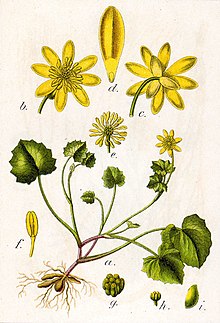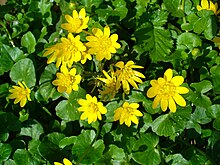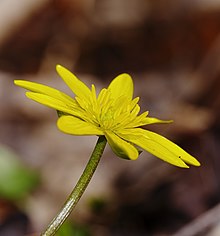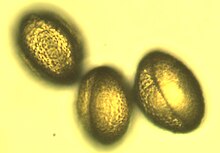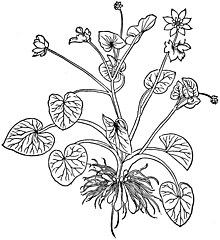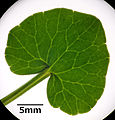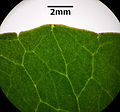Celandine
| Celandine | ||||||||||||
|---|---|---|---|---|---|---|---|---|---|---|---|---|
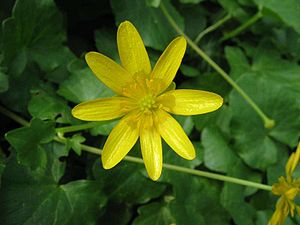
Lesser celandine ( Ficaria verna ) |
||||||||||||
| Systematics | ||||||||||||
|
||||||||||||
| Scientific name | ||||||||||||
| Ficaria verna or Ranunculus ficaria | ||||||||||||
| Huds. |
The celandine ( Ficaria verna , syn .: Ranunculus ficaria L.), also called figwort or spring celandine , is a species of the buttercup family (Ranunculaceae). It is a spring bloomer . Its common German name is derived from Scharbock ( scurvy ), as its vitamin C -containing leaves were taken against this deficiency symptom. In German-speaking Switzerland, the plants are also called Glitzerli , because the flower, in contrast to the normal sharp buttercup , glitters, as if painted.
description
The celandine is a spring green, perennial, herbaceous plant that reaches heights of 10 to 20 cm. Every year new root tubers about 1 to 2 cm long, wart- like root tubers are formed to store starch. The renewal buds form on the rhizome just below the surface . The prostrate to ascending, hollow stem is bare.
The undivided leaves have long petioles. The simple leaf blade is heart- to kidney-shaped and often greasy and shiny with a notched leaf margin.
Its single, long-stalked, golden yellow and star-shaped flowers , which have a diameter of 1.5 to 6 cm, are striking . There are three, rarely five sepal-like bracts. There are eight to eleven (in contrast to the buttercup species) petals , which in the botanical sense are petal-like nectar leaves. Their striking coloring attracts numerous insects during the flowering period (March to May), which find nectar on the flower base . When the numerous stamens are touched, pollination takes place .
In contrast to the "real" buttercups Ranunculus s. st. the nuts have an elongated base, the stylus (beak) is reduced.
ecology
The celandine is a hemicryptophyte and a half-rosette plant. The spring plant moves in again as early as May / June, at which point the new tubers are fully developed and the above-ground parts of the plant begin to turn yellow and then wither.
The Ficaria verna subsp. verna (syn .: subsp. bulbifera ) is tetraploid and reproduces almost exclusively vegetatively through bulbils ; These are white, grain-sized spawn nodules that arise from inhibited side shoots, especially in the axils of the lower leaves, later fall to the ground and grow into new plants. The diploid, south-western European parent form Ficaria verna subsp. fertilis (syn .: subsp. verna auct.) the bulbils are usually absent; it multiplies through seeds .
In terms of flower biology, they are “nectar-bearing disc flowers” with calyx-like tepals and petals-like nectar leaves. The nectar leaves show a fat sheen; their epidermis is colored intensely yellow by carotenoids ; underneath there is a white thickness-guiding layer as a reflector. The base does not shine and hardly reflects UV light , so it also serves as a stain sap. The flowers show temperature-dependent growth and closing movements; they are open from 9 a.m. to 5 p.m.
Despite the large number of insect visits, the subsp. verna (syn .: subsp. bulbifera ) almost no fruit set. The germinating seeds have only one cotyledon , contrary to the mode typical of the dicotyledonous class ; the other is stunted. The seeds experience propagation through man with earth.
Vegetative reproduction occurs through the bulbils, which fall off in May, overwinter on the surface of the earth and germinate again in spring. The following spread mechanisms apply to them: self-spread as well as swimming, ants and storage spread.
Diseases
The lesser celandine is of the rust fungi poae Uromyces and Uromyces rumicis with spermogonia and Aecien and Uromyces ficariae with Telien affected.
Occurrence
The celandine is mainly native to Northern and Central Europe . It is also found in Asia Minor and North Africa, but avoids the extreme north in Europe. In the Allgäu Alps in Bavaria at the Trifthütte north of Warth (Vorarlberg) it rises up to 1800 m above sea level.
It usually thrives in damp meadows, bushes, hedges or dense deciduous forests and on the edges of deciduous forests and can be found there in spring. There it usually forms the first green layer of soil ( herb layer ) before the trees develop their leaves. It is a species of the Querco-Fagetea class, but also occurs in societies of the Alliarion or Arrhenatherion associations.
Systematics
relationship
Ficaria verna used to be part of the genus buttercup ( Ranunculus ). Recent studies on phylogeny using DNA sequence analysis by Emadzade et al. have shown, however, that the celandine is not closely related to the "real" buttercups. The sister group to the celandine is the arctic genus Coptidium (with two species, formerly also assigned to Ranunculus ). The closest relatives of Ranunculus are the South American genera Laccopetalum and Krapfia .
Closer related to the species Ficaria verna are the two species Ficaria ficarioides (Bory & Chaub.) Halácsy (Syn .: Ranunculus ficarioides Bory & Chaub. ), Which occurs in Greece, on Karpathos and in the Middle East, and Ficaria fascicularis K.Koch ( Syn .: Ranunculus kochii Ledeb. ), Which occurs in Asia Minor.
Breakdown
The Scharbockskraut was 1753 by Linnaeus in Species Plantarum under the Basionym Ranunculus ficaria L. first published . William Hudson placed it in the genus Ficaria in 1762 and gave it the name Ficaria verna Huds , since the genus and species names for plants must not match .
The type of Ranunculus ficaria L. was identified in 1954 on a specimen from the Linné herbarium belonging to the tetraploid subspecies Ficaria verna "subsp. bulbifera ”. This does not correspond to the nomenclature common up to the 2000s, which was used by the diploid subspecies Ficaria verna "subsp. verna ”came out as a type and made some changes necessary.
There are five subspecies of the celandine ( Ficaria verna Huds. ):
- Ficaria verna subsp. calthifolia (Rchb.) Nyman (Syn .: Ranunculus ficaria subsp. calthifolius (Rchb.) Arcang. , Ficaria calthifolia Rchb. ), occurs in eastern Central Europe and in Southeastern Europe; the number of chromosomes is 2n = 16, 24 or 32.
- Ficaria verna subsp. chrysocephala (PDSell) Stace (Syn .: Ranunculus ficaria subsp. chrysocephalus P.D.Sell ), occurs in the eastern Mediterranean and feral in the British Isles. The number of chromosomes is 2n = 32.
- Ficaria verna subsp. fertilis (Lawralrée ex Laegaard) Stace (Syn .: Ranunculus ficaria subsp. fertilis Lawralrée ex Laegaard , Ficaria verna subsp. verna auct. , Ranunculus ficaria subsp. ficaria auct. ) is a clan from western and southwestern Europe; the number of chromosomes is 2n = 16.
- Ficaria verna subsp. ficariiformis (FW Schultz) B. Walln. (Syn .: Ranunculus ficaria subsp. Ficariiformis Rouy & Fouc. ), Occurs in the western and central Mediterranean area and with uncertain status in Western Europe; the number of chromosomes is 2n = 32.
- Ficaria verna Huds. subsp. verna (Syn .: Ranunculus ficaria subsp. ficaria , Ficaria verna subsp. bulbifera Á. Löve & D. Löve , Ranunculus ficaria subsp. bulbilifer Lambinon ): It has its focus in Central Europe, but also extends to Asia Minor, to northern and southern Europe and to southern northern Europe; the number of chromosomes is 2n = 24 or mostly 32.
toxicology
The celandine is poisonous in all parts, but especially in the rhizome and in the bulbils . However, young leaves that are harvested before flowering are harmless. The main active ingredients are protoanemonin and other unknown substances. Protoanemonin irritates the mucous membranes. Symptoms of poisoning are: nausea, vomiting and diarrhea.
use
Useful plant
If you harvest the young leaves before the flowers come, you can take them as a small addition to salads or quark. They enrich the food with a "bitter, somewhat hot taste". Only before the flowering period do they seem to contain so little protoanemonin that they can be safely enjoyed in moderate amounts. The amount of protoanemonins does not only depend on the flowering time, but also on the location and soil conditions. The most energetic part of the celandine are the small white storage nodules in the leaf axils and on the roots. If a “pungent, bitter” taste occurs in a taste test, the collected parts of the plant should be dried before consumption in order to detoxify them.
It is dangerous to mix them up with other buttercups because they contain much larger amounts of toxins.
Lesser celandine used to be part of the travel provisions on sea voyages and was eaten by seafarers who usually had no fresh vegetables and fruit available. Lesser celandine contains a lot of vitamin C and thus prevented scurvy , a vitamin C deficiency disease that seafarers used to threaten on their long voyages. The name celandine is derived from celandine, an old name for scurvy.
Today celandine is no longer of any importance in medicine.
Ornamental plant
The celandine is used as an ornamental plant for groups of trees and lawns. There are around 50 varieties (selection):
- 'Albus': The corolla is creamy white.
- 'Bowles Double': The flowers are double, their center is initially green and later turns yellow.
- 'Brambling': The leaves are dark with silver spots.
- 'Coppernob': The corolla is orange.
- 'Cupreus' ('Aurantiacus'): the leaves are silver and have a dark mark.
- 'Damerham': The flowers are yellow, small and double.
- 'Flore Pleno': The flowers are yellow, double, and the back of the petals is green.
- 'Yaffle': The corolla is green with yellow.
photos
Ficaria verna subsp. verna
Leaf margin of Ficaria verna subsp. verna : the hydathodes (light point) are located at the tip of the indistinct leaf marginal crenal teeth, the notches between the teeth are very narrow
Ficaria verna subsp. calthifolia
literature
- Oskar Sebald: Guide through nature. Wild plants of Central Europe . ADAC Verlag, Munich 1989, ISBN 3-87003-352-5 , p. 26 .
- Deni Bown: Dumont's Great Herbal Encyclopedia. DuMont, Cologne 1998, ISBN 3-7701-4607-7 , p. 339.
- Elisabeth Mayer: wild fruits, wild vegetables, wild herbs. Leopold Stocker, Graz 2001, ISBN 3-7020-0835-7 , pp. 25-26.
- Ruprecht Düll , Herfried Kutzelnigg : Pocket dictionary of plants in Germany and neighboring countries. The most common Central European species in portrait . 7th, corrected and enlarged edition. Quelle & Meyer, Wiebelsheim 2011, ISBN 978-3-494-01424-1 , p. 349–351 (section ecology).
- Lutz Roth , Max Daunderer , Kurt Kormann : Poison Plants - Plant Poisons. Poisonous plants from AZ. Emergency assistance. Occurrence. Effect. Therapy. Allergic and phototoxic reactions . 4th edition. Nikol, Hamburg 2000, ISBN 3-933203-31-7 (reprint from 1994).
- Ingrid Schönfelder, Peter Schönfelder : The new manual of medicinal plants. New edition. Franckh-Kosmos, Stuttgart 2011, ISBN 978-3-440-12932-6 .
Web links
- Celandine. In: FloraWeb.de.
- Celandine . In: BiolFlor, the database of biological-ecological characteristics of the flora of Germany.
- Profile and distribution map for Bavaria . In: Botanical Information Hub of Bavaria .
- Ranunculus ficaria L. In: Info Flora , the national data and information center for Swiss flora .
- Distribution in the northern hemisphere from: Eric Hultén, Magnus Fries: Atlas of North European vascular plants. 1986, ISBN 3-87429-263-0 at Den virtuella floran. (swed.)
- Thomas Meyer: Data sheet with identification key and photos at Flora-de: Flora von Deutschland (old name of the website: Flowers in Swabia ) Ficaria verna subsp. calthifolia
- Thomas Meyer: Data sheet with identification key and photos at Flora-de: Flora von Deutschland (old name of the website: Flowers in Swabia ) Ficaria verna subsp. verna
- Nature lexicon: celandine.
Individual evidence
- ↑ a b Peter Derek Sell: Ranunculus ficaria L. sensu lato. In: Watsonia. Volume 20, No. 1, pp. 41-50, PDF file .
- ↑ Peter Zwetko: The rust mushrooms Austria. Supplement and host-parasite directory to the 2nd edition of the Catalogus Florae Austriae, III. Part, Book 1, Uredinales. (PDF; 1.8 MB).
- ↑ Erhard Dörr, Wolfgang Lippert : Flora of the Allgäu and its surroundings. Volume 1, IHW, Eching 2001, ISBN 3-930167-50-6 , p. 549.
- ^ Erich Oberdorfer : Plant-sociological excursion flora for Germany and neighboring areas . With the collaboration of Angelika Schwabe and Theo Müller. 8th, heavily revised and expanded edition. Eugen Ulmer, Stuttgart (Hohenheim) 2001, ISBN 3-8001-3131-5 , pp. 405 .
- ↑ Khatere Emadzade, Carlos Lehnebach, Peter Lockhart, Elvira Hörandl: A molecular phylogeny, morphology and classification of genera of Ranunculeae (Ranunculaceae). In: Taxon Volume 59, No. 3, 2010, pp. 809-828, PDF file .
- ↑ Peter Hadland Davis: Ranunculus (except Subgen. Batrachium). Peter Hadland Davis (Ed.): Flora of Turkey and the East Aegean Islands. Vol. 1 (Pteridophyta to Polygalaceae) . Edinburgh University Press, Edinburgh 1965, ISBN 0-85224-159-3 , pp. 193-195 (reprinted 1997).
- ↑ Carl von Linné: Species Plantarum . Volume 1, Lars Salvius, Stockholm 1753, p. 550, digitized .
- ^ William Hudson: Flora Anglica. Self-published, London 1762, p. 214, preview in Google book search.
- ↑ Simon Lægaard: Validation of Ranunculus ficaria L. ssp. fertilis Clapham ex Lægaard (Ranunculaceae) (= Flora Nordica Notes No. 27.). In: Nordic Journal of Botany. Volume 20, No. 5, 2001, pp. 525-526, doi: 10.1111 / j.1756-1051.2000.tb01597.x .
- ^ Clive A. Stace: Eleven new combinations in the British Flora. In: Watsonia. Volume 27, No. 2, pp. 243-248, PDF file .
- ↑ a b celandine as a poisonous plant .
- ↑ a b c Meret Bissegger: My wild vegetable kitchen . Identifying, collecting and cooking wild plants. 2nd Edition. AT Verlag, Aarau / Munich 2011, ISBN 978-3-03800-552-0 , p. 35.
- ↑ Johannes Vogel: Vegetable emergency food. Survival knowledge for extreme situations. 1st edition. peitsch, Stuttgart 2012, ISBN 978-3-613-50677-0 , pp. 176-178.
- ^ University of Oldenburg: Biology , accessed on March 11, 2012.
- ↑ Eckehart J. Jäger, Friedrich Ebel, Peter Hanelt, Gerd K. Müller (eds.): Exkursionsflora von Deutschland . Founded by Werner Rothmaler. tape 5 : Herbaceous ornamental and useful plants . Springer, Spektrum Akademischer Verlag, Berlin / Heidelberg 2008, ISBN 978-3-8274-0918-8 , pp. 147 .

